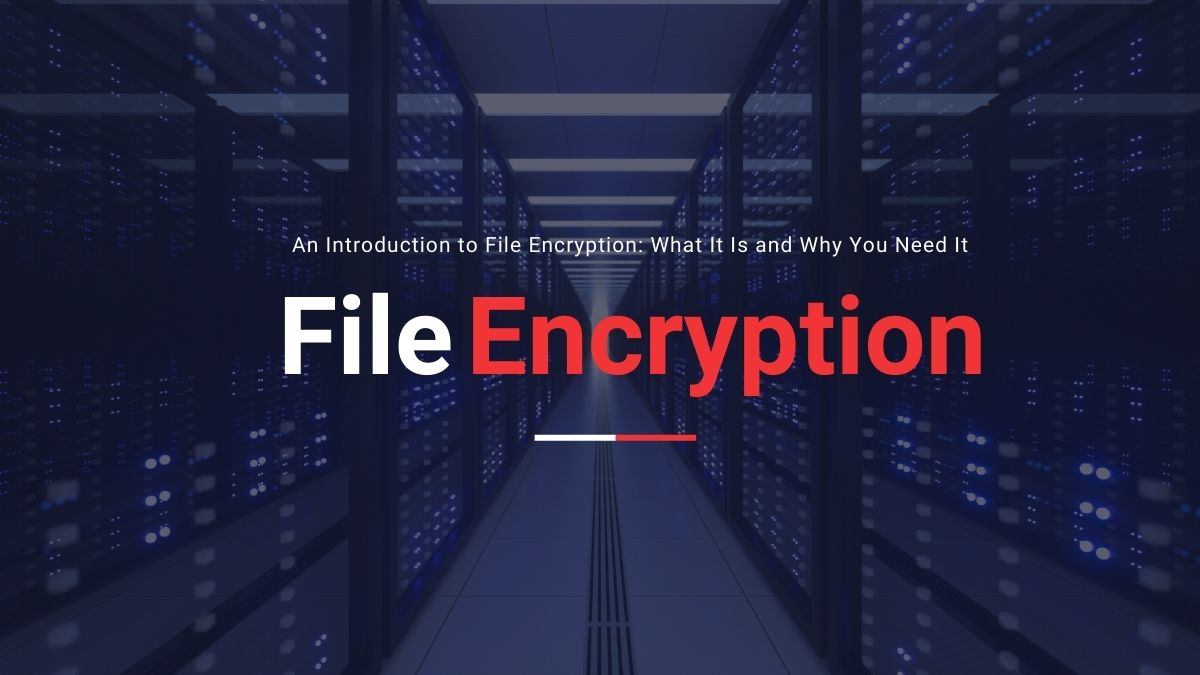
Information flows seamlessly across the internet in today’s increasingly digital world. It is crucial to protect your sensitive data by using all effective methods. One of the most efficient and fundamental tools in the world of cybersecurity is file encryption, which provides a robust way of protecting your information from unauthorized access.
This article will dive into the fundamental concepts of file encryption, its impact, and why incorporating it into your digital routine is critical.
What is file encryption?
At its core, file encryption refers to changing readable data, known as plaintext, into an indecipherable format, commonly called ciphertext. An individual can execute this transformation by utilizing encryption algorithms that rely on encryption keys, which are unique sequences of characters used to lock and unlock the target data.
The encryption process ensures that even if an unauthorized party gains access to the encrypted data, they still need the corresponding decryption key to revert it to its original and readable form.
Encryption algorithms fall into two primary categories, which users call symmetric encryption and asymmetric encryption.
Symmetric encryption
Symmetric encryption involves the utilization of a single key for both encryption and decryption. In this approach, the essential exchange process is critical to maintaining security, so the sender and the receiver must share this key in advance.
While symmetric encryption offers quick and efficient processing, it may pose significant challenges for securely sharing the encryption key.
Practical applications of symmetric encryption
Symmetric encryption has many different real-life applications involving communications and sensitive data security. Here are some of the best examples of symmetric encryption in everyday scenarios.
Secure email communication – Email services typically utilize symmetric encryption to secure email content. An excellent example is the Transport Layer Security or TLS protocol, which uses symmetric encryption to establish a secure channel between clients and email services to ensure the secure transmission of email content.
Full disk encryption – Devices and operating systems provide full disk encryption to safeguard the data saved on them. For instance, Windows’s BitLocker, Linux’s dm-crypt, and macOS’s FileVault utilize symmetric encryption to encrypt the entire storage device that requires the user to provide a password or decryption key to access the information.
Databases and data storage – Organizations typically encrypt their data in files and databases using symmetric encryption. Encrypting these files and databases is crucial when handling financial data, personal information, or other confidential records.
Virtual private networks or VPNs – Virtual private networks utilize symmetric encryption to secure the connection between the user’s device and the VPN server. This system ensures that data transmissions over the internet remain confidential and secure from eavesdropping.
Secure messaging applications – Messaging apps like Telegram, Signal, and WhatsApp utilize symmetric encryption to ensure the confidentiality of the messages exchanged between their users. Whenever two users communicate, their devices create a shared symmetric key for encrypting and decrypting messages.
Payment card transactions – Online payment gateways and point-of-sale or POS systems utilize symmetric encryption to secure payment card information during transactions.
Remote desktop access – Applications that allow you to access a computer remotely often utilize symmetric encryption to secure the connection and the information transmitted between the host computer and the remote device.
Wireless networks – Wi-Fi networks utilize symmetric encryption protocols like Wi-Fi Protected Access 2 or WPA2 to secure wireless communication between the network router and the connected devices.
Media and software protection – Media content, like videos, music, and even eBooks, and software applications often have symmetric encryption to protect them from unauthorized distribution or duplication.

Asymmetric encryption
Also called public-key encryption, asymmetric encryption entails using a pair of keys. These are the public key utilized for encryption and the private key used for decryption. You can distribute the public key openly, allowing users to encrypt data. In contrast, the private key must remain with the intended recipient for decryption.
Asymmetric encryption is the solution to the fundamental distribution problem present in symmetric encryption. However, it is typically slower and requires more computational resources.
Practical applications of asymmetric encryption
Asymmetric encryption has a variety of practical applications that enable secure data exchange, authentication, and communication. Here are some of the best examples of asymmetric encryption used in everyday scenarios.
Secure web communication – When you access a webpage utilizing HTTPS or secure HTTP, asymmetric encryption establishes a secure connection between your browser and the web server. You use the server’s public key to encrypt the data that only the server’s private key can decrypt.
This system ensures that your private data, such as credit card information and login credentials, remains confidential during transmission.
Digital signatures – Users can utilize asymmetric encryption to create digital signatures that verify the integrity and authenticity of emails, transactions, and digital documents. The sender utilizes their private key to encrypt a hash of the message, and the recipient can use the sender’s public key to verify the signature.
Secure file distribution – Users utilize asymmetric encryption on specific file-sharing platforms to allow other users to encrypt files with the recipient’s public key before distributing. Only the recipient that possesses the corresponding private key can decrypt and gain access to the distributed file.
Secure shell (SSH) – Secure shell utilizes asymmetric encryption to build specific remote channels to servers and devices. The client and server exchange public keys during the initial handshake and generate encryption keys derived from these public keys.
Secure online transactions – Asymmetric encryption plays a role in secure key exchange during online transactions. One excellent example is when asymmetric encryption helps establish a secure connection for transmitting payment details to the payment gateway during credit card transactions.
Virtual private networks or VPNs – Virtual private networks often utilize asymmetric and symmetric encryption to establish secure channels between the VPN servers and their users. The public keys are for the initial key exchange, while symmetric keys are for data encryption. Secure software distribution – Developers can use asymmetric encryption to sign software updates digitally. That ensures that users can verify the integrity and authenticity of these updates.

The Importance of File Encryption
File encryption is integral to maintaining the security and privacy of data in various contexts. Here are some of the main reasons that showcase the importance of file encryption for individuals and organizations.
Confidentiality
File encryption ensures that even if an unauthorized user gains access to the encrypted data, they cannot decipher it without the corresponding decryption key. That protects sensitive information such as financial records, business secrets, and personal identification details.
Data integrity
Encryption not only secures information from snooping eyes, but it also protects it from tampering during storage or transmission. Any unauthorized modification to the encrypted file will render it unreadable after decrypting it, alerting the recipient of potential security breaches.
Regulatory compliance
In most industries, regulatory standards mandate the security of specific data types. Encryption is a crucial component of compliance strategies to help organizations avoid penalties and meet legal requirements.
Safe cloud storage
While cloud services offer convenient solutions for storing data, they also raise concerns about the privacy and security of that data. Encrypting data or files before uploading them to the cloud ensures your information remains unreadable without the encryption key, even if the service provider’s security gets compromised.
Protection against cyberattacks
Cybercriminals constantly evolve their strategies to exploit vulnerabilities. Encrypting your files provides an extra layer of security against data breaches, unauthorized access, and ransomware attacks.
File Encryption Implementation
Implementing file encryption involves complex steps to ensure data security and confidentiality. To employ file encryption effectively, you must consider choosing encryption algorithms, securely managing keys, utilizing encryption software, and regularly updating and auditing.
Choose encryption algorithms
Select the appropriate encryption algorithms according to your security requirements. Widely utilized algorithms include Advanced Encryption Standard or AES for symmetric encryption and Rivest-Shamir-Adleman or RSA for asymmetric encryption.
Manage keys securely
Proper key management is critical. Utilize strong and unique encryption keys and protect them from unauthorized users. Consider employing hardware security modules or password managers to add an extra layer of protection.
Utilize encryption software
Many encryption software tools are available for various platforms, making the encryption process accessible and user-friendly. These tools often integrate seamlessly with cloud services and file systems.
Regularly update and audit
Encryption is not a one-and-done task. You must regularly update your encryption algorithms and software to stay on top of potential vulnerabilities. Conduct regular audits to ensure the proper implementation and adherence to standard security practices.
Secure Everything With File Encryption
File encryption is the foundation of modern cybersecurity that defends users against a wide range of threats to sensitive information. Whether you are an individual protecting your personal information or an organization safeguarding critical assets, incorporating file encryption is a non-negotiable aspect of maintaining digital security in a rapidly interconnected world.




